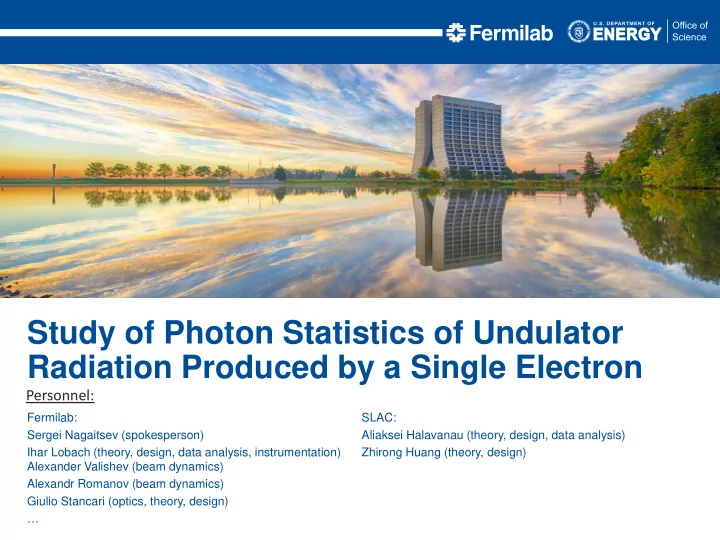

Study of Photon Statistics of Undulator Radiation Produced by a Single Electron Personnel: Fermilab: SLAC: Sergei Nagaitsev (spokesperson) Aliaksei Halavanau (theory, design, data analysis) Ihar Lobach (theory, design, data analysis, instrumentation) Zhirong Huang (theory, design) Alexander Valishev (beam dynamics) Alexandr Romanov (beam dynamics) Giulio Stancari (optics, theory, design) …
Study of Photon Statistics of Undulator Radiation Produced by a Single Electron Motivation: • Observation of Sub-Poisson statistics in a previous experiment with FEL radiation: • Preparation for the more complex experiment: Hong-Ou-Mandel (or Mach- Zehnder) interferometry of undulator radiation produced by a single electron 2 11/8/2019 Ihar Lobach | IOTA/FAST Department Meeting
Detector: Single Photon Avalanche Diode Excelitas SPCM-AQRH-10 *we have experience in Active area (diameter) 180 μm focusing the radiation Photon detection 65% on such a small area efficiency at 650 nm *can be reduced by Dark count ∼ 100 cps using a gate ( ∼ 3 ns ) Dead time 22 ns *IOTA revolution: 133 ns Pulse height 2 V Pulse length 10 ns Comparison with the previous experiment regarding Sub-Poisson photon statistics: • Quantum efficiency was only 12% • Detector’s dead time could affect the observed statistics We will be able to detect deviations from Poisson statistics as small as 1-2% 3 11/8/2019 Ihar Lobach | IOTA/FAST Department Meeting
Sample SPAD pulse 4 11/8/2019 Ihar Lobach | IOTA/FAST Department Meeting
Proposed measurements • Divide waveform into equal time windows • 2060 IOTA periods in this example • Count number of pulses in each time window • Plot distribution for this number The question to answer is: Is this Poisson statistics or Sub-Poisson statistics? var 𝑂 =? 𝑂 5 11/8/2019 Ihar Lobach | IOTA/FAST Department Meeting
SRW simulations @ 100 MeV for SLAC undulator Second harmonic Fundamental Total quantum efficiency includes the quantum efficiency of the SPAD, losses in the mirrors, transmission functions of the low-pass and high-pass spectral filters, losses in the focusing lens About 60K photon counts per second. 6 11/8/2019 Ihar Lobach | IOTA/FAST Department Meeting
Beam requirements • Nominal IOTA Lattice with the SLAC undulator in “IN” position • Bunch length 𝜏 𝑨 of about 1 ns (30 cm) or shorter • Beam current from single/few electrons to ~2mA (for alignment and diagnostics) • Beam lifetime (for single/few electrons) >10 min • Beam energy 100 MeV (to study second harmonic) • Capability to work at 150 MeV (to study fundamental) would be great 7 11/8/2019 Ihar Lobach | IOTA/FAST Department Meeting
Run plan • Three 8hr shifts for initial alignment, tests with a bunch of electrons • Five 8hr shifts for studies in the single electron (few electrons) regime • 1-2 days between the shifts to analyze the data and plan next shift • We are ready for the first shift as soon as we have beam in IOTA 8 11/8/2019 Ihar Lobach | IOTA/FAST Department Meeting
Apparatus • 120 ms-long waveforms with 3 ns time step (about 7000 single photon events) • They will be analyzed offline • Channel 1: Detector signal • Channel 2: IOTA clock • It would be great to have an independent way to check how many electrons are stored in the ring (PMTs) 9 11/8/2019 Ihar Lobach | IOTA/FAST Department Meeting
Apparatus: Current state 10 11/8/2019 Ihar Lobach | IOTA/FAST Department Meeting
Challenges. Advice very welcome • Picomotors are too slow for z (longitudinal) direction. We need something faster with micro meter accuracy Stepper motors? How to mount them on our 3D movable stage? • How to align detector pulses with IOTA clock • Procedure to focus the light on the sensitive area of the detector (180 𝜈𝑛 ) 11 11/8/2019 Ihar Lobach | IOTA/FAST Department Meeting
Study of noise in the SPAD detector signal Total noise before gating: ~100 cps • Null hypothesis: This is Poisson statistics. • Calculate p-value from Chi-squared test. • p-value = 0.36 • Conclusion: the deviations can be explained by chance. It is very likely that this actually is Poisson statistics. 12 11/8/2019 Ihar Lobach | IOTA/FAST Department Meeting
“Simulating” undulator light with a fast red LED Pulse Fast LED generator Scope SPAD 13 11/8/2019 Ihar Lobach | IOTA/FAST Department Meeting
Study of synchrotron oscillations We would like to measure the electron RF phase with respect to the cavity phase on every turn and then get a phase-space trajectory. From that, we can find the synchrotron frequency and hence the RF voltage. • Requirements: – Long bunch (e.g., 3𝜏 𝑨 = 20 𝑛 ), because the detector’s time resolution is ~0.35 ns 14 11/8/2019 Ihar Lobach | IOTA/FAST Department Meeting
Recommend
More recommend